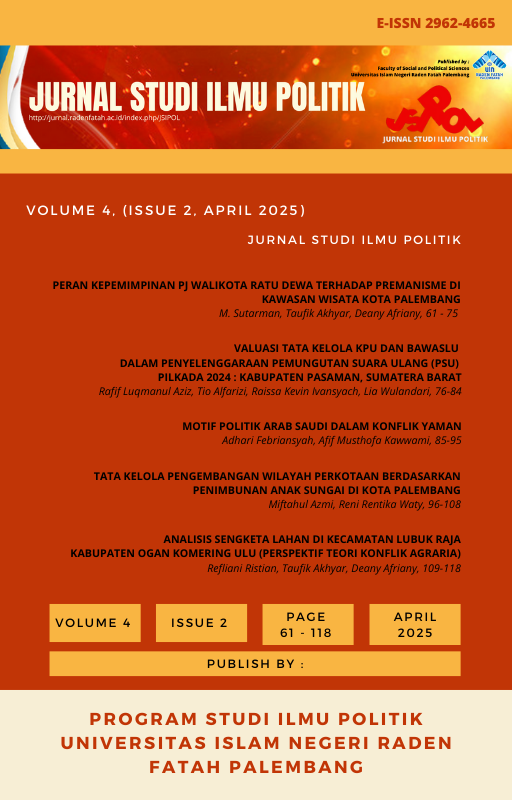Motif Politik Arab Saudi dalam Konflik Yaman
Main Article Content
Abstract
One example of a prolonged conflict in the region is the conflict between Saudi Arabia and Yemen, which has also influenced the geopolitical dynamics of the Middle East. The conflict in Yemen began with a political dispute between the government of Ali Abdullah Saleh and his supporters with the rebels who later collaborated with the Houthi group. The aim is to understand the political motives in the conflict between Saudi Arabia and Yemen. This research method is a type of library research, which is based on the study and review of texts with primary data sourced from the book Saudi Interventions in Yemen, A Historical Comparison of Ontological Insecurity-Routledge, which is used to discuss the political motives of Saudi Arabia in the Yemen conflict. This study discusses three main motives that drive involvement in this conflict, namely 1) Material Incentive Motive, 2) Solidarity Incentive Motive, 3) Idealism Incentive Motive. Material Incentive Motive, In this case, there are two factors that influence the material incentive motive, namely seizing control of oil and expanding the Gulf region. Solidarity Incentive Motive, Yemen is the worst humanitarian disaster in the world. The biggest response in the world. Although religion is not the primary driver of the conflict in Yemen, the major groups involved in the fighting do differ in terms of religious identity, Ethnic and religious differences in Yemen which consists of several different ethnic and religious groups, including Sunni and Shia.
Downloads
Article Details

This work is licensed under a Creative Commons Attribution-ShareAlike 4.0 International License.
Authors who publish with this journal agree to the following terms:
- Authors retain copyright and grant the journal right of first publication with the work simultaneously licensed under a Creative Commons Attribution License that allows others to share the work with an acknowledgement of the work's authorship and initial publication in this journal.
- Authors are able to enter into separate, additional contractual arrangements for the non-exclusive distribution of the journal's published version of the work (e.g., post it to an institutional repository or publish it in a book), with an acknowledgement of its initial publication in this journal.
- Authors are permitted and encouraged to post their work online (e.g., in institutional repositories or on their website) prior to and during the submission process, as it can lead to productive exchanges, as well as earlier and greater citation of published work
How to Cite
References
Al-Deen, M. S. (2023). Yemen Religion, Peace and Conflict Country Profile. Di akses pada 28
Desember 2024 dari https://www.usip.org/programs/religion-and-conflict
countryprofiles/yemen
Aldino, A. P. GEOPOLITIK: TEORI DAN KAJIAN.
Alhadar, S. et al. (2022) ‘KAJIAN PERAN DAN MOTIF : PARTAI MAHASISWA
INDONESIA (PMI) DALAM PERSPEKTIF PHILANTHROPY’, IX, pp. 413–421.
Al-Qadhi, M. H. (2017). The Iranian role in Yemen and its implications on the regional security.
Arabian Gulf Centre for Iranian Studies.
Afifah, I., dan Sopiany, H. M. (2017). Penerapan Pembelajaran Kooperatif Dengan Metode
Eksperimen Dan Metode Talking Stick Terhadap Motivasi Belajar Dan Kemampuan
Berpikir Kritis Siswa Pada Materi Tekanan. INSTITUT AGAMA ISLAM NEGERI
PALANGKA RAYA, 87 (1,2), 149–200.
Arianto, A., Zetra, A. dan Fadhilah, R.R. (2021) ‘Konflik Politik dalam Kepengurusan Partai
di Sumatera Barat’, 1(1), pp. 76–84.
Arikunto, S. (2006). Prosedur Penelitian Suatu Pendekatan Praktik. Jakarta: PT.Rineka Aris
Sarjito dan Editha Praditya Duarte. (2023). Geopolitik dan Geostrategi Pertahanan:
Tantangan Keamanan Global. Bandung: Indonesia Emas Group.
Murofikoh, Dede Ika, D.I.A. dan N. (2022) ‘Perbandingan Ideologi Negara Indonesia dengan
Arab Saudi’, 1(02), pp. 188–196
Mustahyun (2016) ‘Rivalitas Arab Saudi Dan Iran Di Timur Tengah Pada Arab Spring Suriah
Tahun 2011 2016’, 1(1).
Natasya, P. P. (2023). Kepentingan Nasional Amerika Serikat dalam Menginisiasi
Pembentukan Indo-Pacific Economic Framework (IPEF) (Doctoral dissertation).
Nirwasita, J. dan Latupella, G.C. (2024) ‘Dampak Politik Konflik Yaman Tahun 61 2011’, 5(1),
pp. 7–13
Priambodo, S. (2017) ‘Motif Intervensi Arab Saudi Terhadap Perang Saudara di Yaman’, 6(1),
pp. 205–216.
Rizki Pratama, P. (2018). Intervensi Militer Arab Saudi Terhadap Konflik Yaman Untuk
Membendung Pengaruh Iran Di Timur Tengah (Doctoral dissertation, Universitas Andalas).
Putra, R.P. et al. (2019) ‘INTERVENSI MILITER ARAB SAUDI TERHADAP
KONFLIK YAMAN UNTUK MEMBENDUNG PENGARUH IRAN DI 62 TIMUR TENGAH’, 4(1), pp. 76–99.
Saputra, A.A. and Al-hamdi, R. (2020) ‘Motif Politik dalam Kelahiran dan Pembentukan
Gerakan Arah Baru Indonesia (Garbi)’, 11(2), pp. 163–182. Available at:
https://doi.org/10.14710/politika.11.2.2020.163-182.
Sari, A.I. (2020) ‘Peranan Organisasi Regional Liga Arab Dalam Penyelesaian Konflik Yaman
Arab Saudi Tahun 2011-2017.Skripsi thesis, Universitas Airlangga’, pp. 1–20.
Sastrohamidjojo, H. (2021). Kimia Minyak Atsiri. Yogyakarta: Gadjah Mada University Press.
Setiawan, A. (2018). Yaman Negara Kaya Sumber Daya Alam Yang Bikin Iri Arab Saudi. Di
akses pada 02 Januari 2025 dari https://nusantaranews.co/yaman-negara-kaya-sumber
daya-alam-yangbikin-iri-arab-saudi/
Soni, S. (2018). Earlier this year, The Strategy Bridge asked university and professional
military education students to participate in our first annual writing contest by sending
us their thoughts on strategy. Di akses pada 02 Januari 2025 dari
https://thestrategybridge.org/thebridge/2018/10/30/terrorism-in-civil-wars
Soepandji, K.W. (2020) ‘Geopolitik, Negara, dan Bangsa Masa Kini’, Jurnal Lemhannas RI,
(1), pp. 41–58. Available at: https://doi.org/10.55960/jlri.v7i1.50.

